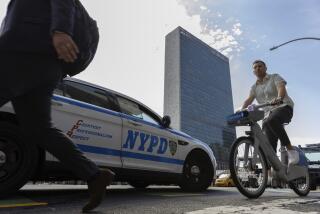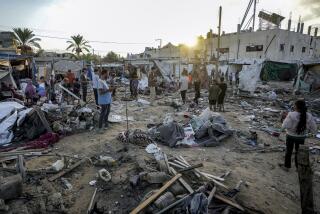U.N. Peacekeeping Force in Tough, Unfamiliar Battle for Money, Image
- Share via
UNITED NATIONS — In half a dozen of the world’s hottest spots, a blue-helmeted army of 10,000 U.N. soldiers is trying to wage peace on the killing grounds of war.
United Nations peacekeepers are the men in the middle, the buffer in regional conflicts. And now, after decades of seldom-noticed service in the cause of peace, they are also in the midst of a battle over image and money.
Last February, in the U.S. television miniseries “Amerika,” U.N. soldiers were depicted as murderers, rapists and mercenaries in service of Soviet occupiers of the United States.
The United Nations’ response came in April. In a 30-second public-service TV spot broadcast in U.S. prime time, a U.N. peacekeeper declared, “I’m not on anyone’s side.
‘I’m in the Middle’
“I’m in the middle . . . between Arab and Israeli, Greek and Turk, Indian and Pakistani, keeping them apart so the world stays together,” the spokesman said.
Some U.N. officials favored responding to “Amerika” with silent disdain. But Secretary General Javier Perez de Cuellar felt the need to launch a public relations campaign because the image problem went well beyond TV screens. Over the last two years, a negative view of U.N. operations has eroded U.S. congressional support for peacekeeping.
The cutback in peacekeeping funds approved by Congress has drawn an angry reaction from the usually tight-lipped Sir Brian Urquhart, a retired U.N. undersecretary general who directed peacekeeping operations for much of his 40-year U.N. career.
“I think it is simply outrageous,” Urquhart said in an interview. “I think it’s irresponsible, and I think it’s very parochial too.”
$400-Million Debt
The world body’s two biggest peacekeeping operations--in Lebanon and Cyprus--are now more than $400 million in debt.
Since 1948, seven peacekeeping forces and six military-observer missions have involved 400,000 soldiers from more than 50 U.N.-member states. They have cost the United Nations in excess of $3.5 billion, about $1 billion of which has been contributed by the United States.
Peacekeeping also has been costly in lives. More than 700 U.N. soldiers have died in the sometimes violent service of peace.
Today, 10,000 troops from 23 nations serve in three peacekeeping forces and two small observer missions.
Checkpoints Manned
They man checkpoints to curb terrorist infiltration in South Lebanon and provide a comforting margin of security to Cypriot farmers tilling their land near the Green Line dividing that troubled Mediterranean island. They also train their binoculars on the old truce lines of the first Arab-Israeli war and the Indian-Pakistani conflict over Kashmir.
Chapter VII of the U.N. Charter gives the Security Council the power “to take such action by air, sea or land forces as may be necessary to maintain or restore international peace and security.”
The Security Council agreed on a genuine enforcement action only once, when North Korea invaded South Korea in 1950. But that decision was possible only because the Soviet Union, which would have vetoed it, was boycotting the council at the time.
The U.S.-led command in Korea continues to fly the U.N. flag. But the United Nations itself, increasingly under Third World influence, no longer recognizes it as a U.N. peacekeeping operation.
Concept Improvised
The concept of peacekeeping--as opposed to enforcement--was hastily improvised during the 1956 Suez crisis by then-Secretary General Dag Hammarskjold, acting on an idea of Canadian Foreign Secretary Lester B. Pearson.
A 6,000-man U.N. military force was interposed in the Sinai to guarantee a truce and the withdrawal of British, French and, ultimately, Israeli forces from around the Suez Canal.
A moral and political presence more than a military one, the Sinai force had strict orders to fire only if fired upon. It was a standard extended to subsequent U.N. ventures.
Everything about the peacekeeping operations is voluntary, from a nation’s agreement to allow U.N. units on its territory to the provision of troops by U.N. member states.
U Thant Blamed
The success of UNEF I--the first U.N. Emergency Force in the Sinai--became widely appreciated only after its precipitate withdrawal led almost immediately to the 1967 Arab-Israeli conflict. Critics accused then-Secretary General U Thant of yielding too readily to Egyptian President Gamal Abdel Nasser’s demand for UNEF’s withdrawal.
The second Sinai force, UNEF II, formed after the 1973 Yom Kippur War, benefited from its predecessor’s history. It enjoyed broad support until its withdrawal in 1979, following the U.S.-mediated Camp David peace accords between Egypt and Israel.
It was replaced by a non-U.N. force of 2,600 men from 11 nations, including the United States. The United Nations, deeply divided over the Camp David accords, maintains only a token observer presence in the Sinai that goes back to the truce that ended the 1948 Arab-Israeli War.
The largest U.N. peacekeeping operation was launched in 1960 as a paroxysm of violence accompanied independence in the former Belgian Congo, now called Zaire. At its peak, the force had 20,000 men from 35 countries, and they suffered more than 200 casualties.
‘It Was a Nightmare’
During the operation, U.N. troops stepped out of their passive role as peacekeepers and swung into action to end the secessionist movement in Katanga province.
“It was a nightmare,” said Urquhart, who was in charge of U.N. operations in Katanga at the time. But he said that the United Nations managed to get away with such direct intervention because it was fighting a “rag-tag” secessionist movement on behalf of a legitimate central government.
“We left the Congo with a central government and at least with some hope of running its major institutions,” Urquhart said. “It didn’t fall to bits. It’s still a country.”
In contrast, U.N. peacekeepers were criticized for not doing enough to halt the Turkish invaders in Cyprus in 1974 and the Israeli invasion force in Lebanon eight years later.
‘Limited Device’
The 2,200-man U.N. Force in Cyprus had been on the island since intercommunal violence erupted there in 1964. The 5,700-man U.N. Interim Force in Lebanon (UNIFIL) was formed in 1978 after a limited Israeli thrust into southern Lebanon.
A peacekeeping operation, Urquhart said, is a “limited device, which is extremely useful in a very critical situation when everyone wants to have a pretext to stop fighting.”
However, he said, “if you have two peoples who are absolutely determined to fight . . . you won’t stop them” with a lightly armed peacekeeping force.
United Nations officials point to the disasters, including devastating car bombings, that befell the heavily armed U.S.-French Multinational Force in Lebanon to bolster their argument that taking sides can be fatal to a peacekeeping operation.
Treacherous Battlefield
The Lebanon battlefield has been treacherous for U.N. peacekeepers as well. France repositioned its UNIFIL contingent and reduced it from 1,380 to 520 men last year after clashes with local Muslim militiamen left four French peacekeepers dead.
In 1982, when it invaded Lebanon for a second time, Israel complained that UNIFIL was ineffective in preventing infiltration by Palestinian guerrillas into the Israel border area. This perception of an untrustworthy peacekeeping force led to U.S. congressional funding cuts and put the United States $38 million in arrears for UNIFIL.
The U.S. arrears are expected to mount to $60 million by next year. The Reagan Administration, sensing the congressional mood, has asked for only $19.3 million in its 1988 budget, less than half of the expected assessment of $45 million or 25% of UNIFIL’s expenses.
The U.S. cuts came just when the Soviet Union, for the first time in eight years, agreed to start paying its share for UNIFIL. But the Soviets have made no move to make up their $163 million in arrears.
Soldier Pay Cuts
One well-placed U.S. official, who deals with U.N. matters and spoke with a reporter on the condition of anonymity, said that Congress’ cost-cutting action was compelling “the people who are willing to put their lives on the line to also pay for the privilege.”
More to Read
Sign up for Essential California
The most important California stories and recommendations in your inbox every morning.
You may occasionally receive promotional content from the Los Angeles Times.













